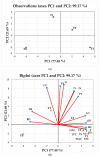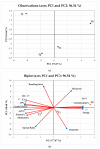The Impact of Innovative Plant Sources (Cordia myxa L. Fruit (Assyrian Plum) and Phoenix dactylifera L. Biowaste (Date Pit)) on the Physicochemical, Microstructural, Nutritional, and Sensorial Properties of Gluten-Free Biscuits
- PMID: 35954112
- PMCID: PMC9368538
- DOI: 10.3390/foods11152346
The Impact of Innovative Plant Sources (Cordia myxa L. Fruit (Assyrian Plum) and Phoenix dactylifera L. Biowaste (Date Pit)) on the Physicochemical, Microstructural, Nutritional, and Sensorial Properties of Gluten-Free Biscuits
Abstract
The gluten-free products available on the markets are deficient in bioactive compounds and high in cost. The present study is designed to develop gluten-free biscuits with enhanced nutritional properties. The gluten-free biscuits are formulated with rice flour (RF) incorporated with Assyrian plum fruit flour (APF) and bio-waste date-pit flour (DPF) according to the following ratios; RF:DPF:APF (100:0:0)/T0, (90:5:5)/T1, (80:10:10)/T2, and (70:15:15)/T3. The results demonstrate that flour blends with different concentrations of APF and DPF incorporated in RF have high contents of protein, damaged starch, crude fiber, ash, phytochemicals, and antioxidants in contrast to 100% RF, which shows the lowest values for all these parameters. The pasting properties of the flour blends reveals that the values of peak, final, breakdown, and setback viscosities reduce from T1 to T3. Similarly, a differential scanning calorimeter reveals that the phase transition temperature of the flour blends decreases with the increasing amylose content. Moreover, the scanning electron microscopy of the biscuit samples shows a positive contribution of APF and DPF for the development of the desired compactness of the structure due to the leaching of amylose content from the starch. The total phenol content (TPC) and total flavonoid content (TFC) increase from 38.43 to 132.20 mg GAE/100 g DW and 18.67 to 87.27 mg CE/100 g DW, respectively. Similarly, the antioxidant activities of biscuits improved. The protein and fiber contents of the biscuits increased from 10.20 to 14.73% and 0.69 to 12.25%, respectively. The biscuits prepared from T3 resulted in a firmer texture with a reduced spread ratio. However, the formulation of T1 and T2 biscuit samples contributed to desirable physical and sensory properties. Therefore, the addition of DPF and APF to RF is a sustainable way to make gluten-free biscuits as they provide adequate amylose, damaged starch, and fiber content to overcome the essential role of gluten in the baked product with nutraceutical properties.
Keywords: bakery; bioactive compounds; gluten-free biscuits; pasting properties; scanning electron microscopy; sensory analysis.
Conflict of interest statement
There are no competing interest declared by any of the authors.
Figures






References
-
- Sulieman A.A., Zhu K.X., Peng W., Hassan H.A., Obadi M., Siddeeg A., Zhou H.M. Rheological and quality characteristics of composite gluten-free dough and biscuits supplemented with fermented and unfermented Agaricus bisporus polysaccharide flour. Food Chem. 2019;271:193–203. doi: 10.1016/j.foodchem.2018.07.189. - DOI - PubMed
Grants and funding
LinkOut - more resources
Full Text Sources
Medical
Research Materials
Miscellaneous

